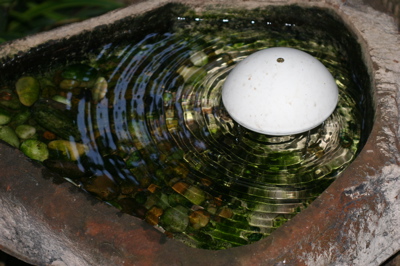- Bird Accessories, Bird Feeders, Bird Nesting Materials, Hummingbird Feeders, Nesting Material, Uncategorized, Window Hummingbird Feeder
add this near your window hummingbird feeder
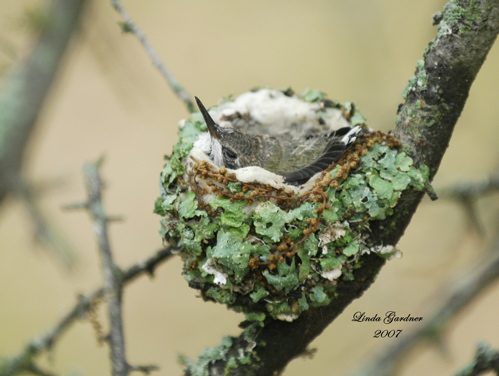 With the hummingbird migration in full swing, it won’t be long before the tiny sprites are in your neck of the woods. Already spotted in LA, SC, TX and all along the Gulf Coast, its just a few short weeks before they’ll infiltrate up the East Coast and Midwest, ultimately reaching Alaska, British Columbia and Canada.
With the hummingbird migration in full swing, it won’t be long before the tiny sprites are in your neck of the woods. Already spotted in LA, SC, TX and all along the Gulf Coast, its just a few short weeks before they’ll infiltrate up the East Coast and Midwest, ultimately reaching Alaska, British Columbia and Canada.Aside from your hanging or window hummingbird feeder, you can further entice hummers with moving water such as birdbath fountains and bubblers, and of course, nesting material.
The Hummer Helper nesting material has been tested and proven to increase the numbers and activity of hummingbirds at your feeders. How you might ask? Because if suitable nest sites are found in your yard, juveniles will also visit feeders, including your window hummingbird feeder. If nectar is always kept fresh, and there’s an enticing water feature, you can bet the same hummingbirds will be back next year! They’re known to practice “site fidelity” meaning that attractive diggs will remain their site of choice the following year. Hummer Helper Nesting Material has even been endorsed by The Hummingbird Society for its effectiveness at promoting nesting by hummingbirds.
Hummingbirds aren’t the only ones who will use this nesting material either, American Goldfinches also adore the white fluffy stuff and will use it for their nesting season in late June through July.
Encourage nesting in your yard through wildlife-friendly habitat. Food water and shelter are the keys, whether natural or man-made. Nectar-producing flowers provide food, while shrubs help with predator protection and provide nesting spots, these will attract many species of wild birds. Water is the best way to attract even more feathered friends too. Mature trees, fruit or berry-producing trees, and even brush piles serve many wild birds well. Never throw out or burn garden debris, if space allows, use it to create brush piles in the back of the yard… your wildlife will thank you for this valuable and natural cover!
-
Time to Dust Off those hummingbird feeders
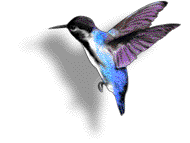 The great hummingbird migration has begun!
The great hummingbird migration has begun!Now is the time to get your hummingbird feeders out from storage and give them a good cleaning for the upcoming season. Plain hot water works, even if you send them through the dishwater, be sure to rinse them thoroughly to remove any residue. Along the Gulf of Mexico, Ruby Throats have started to claim territories, with other species following close behind.
Hummingbird season is an exciting one for many backyard birders, as these little sprites tend to provide some mesmerizing entertainment. Many folks could just sit and watch hummingbirds’ shenanigans for hours on end. Aside from the sugar water in hummingbird feeders, moving water is a very big attraction for them. Bathing, drinking and playing in birdbath fountains or bubblers comes naturally for hummers – they’re drawn to it like a magnet.
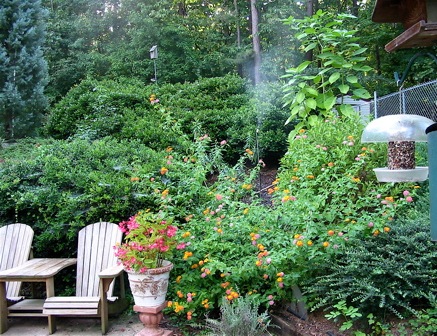 If you’re looking to attract more hummers, but already have enough hummingbird feeders, consider adding moving water to your landscape. Leaf misters for instance, are wildly popular among hummingbirds and butterflies as well. In the scolding heat of summer, the gentle mist is a most welcomed addition for many local wildlife species. Leaf misters may be installed in a variety of fashions. Ours stands upright in the garden twisted around a simple plant stake.
If you’re looking to attract more hummers, but already have enough hummingbird feeders, consider adding moving water to your landscape. Leaf misters for instance, are wildly popular among hummingbirds and butterflies as well. In the scolding heat of summer, the gentle mist is a most welcomed addition for many local wildlife species. Leaf misters may be installed in a variety of fashions. Ours stands upright in the garden twisted around a simple plant stake.Treat your hummingbirds to a fun water feature this season and you’ll be rewarded by increased numbers and some fascinating activity and behaviors from the little guys!
Oh yeah… maybe this is the season to try making your own nectar too. It’s really quite simple and only takes a few minutes. Here’s the recipe: one part plain table sugar (cane) to four parts water. That’s it! Never use anything other than pure cane sugar (white table sugar) as it’s harmful to hummingbirds. There’s really no need to boil the water, we boil one cup simply to dissolve the sugar quicker and more effectively. If you do boil the water, be sure it has cooled before filling your hummingbird feeders. Store extra nectar in the fridge for up to two weeks. Now wasn’t that easy?
-
swap heated bird baths for moving water
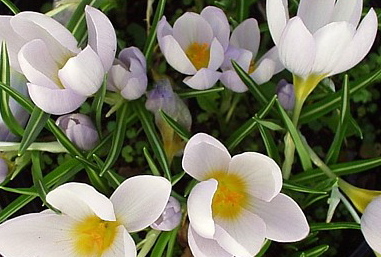 Crocus… the first sign that spring is just around the corner (here in the south anyway) have been popping up along with jonquils. Bluebirds are starting to scout nest boxes in hopes of attracting a mate. Yes, spring is almost here!
Crocus… the first sign that spring is just around the corner (here in the south anyway) have been popping up along with jonquils. Bluebirds are starting to scout nest boxes in hopes of attracting a mate. Yes, spring is almost here!With this exciting birding season come the chores of a responsible backyard birder. Now is the time to check birdhouses for old nests, discard them and clean out the house for new visitors. Remove heated bird baths, or unplug and store the cord for the season.
Cleaning bird feeders is a good idea as well, it helps keep local bird populations healthy. This includes cleaning up fallen seed and ground waste. A simple solution of bleach and water (1:10 ratio) will do the trick nicely. A good scrub for both houses and feeders, rinsed thoroughly and set out to dry is a pretty standard seasonal cleaning.
Two of our baths have heaters for winter (the third one is built in). Heaters should be cleaned as well, removing lime and slime build-up before storing. Our heated bird baths will soon be extremely popular as they will offer moving water. Water wigglers and birdbath drippers will take the place of heaters for the next six or seven months. These are wildly popular with resident as well as migratory birds. Bath water stays fresher longer, and with moving water mosquitoes can not lay eggs.
Easily transform heated bird baths for the spring and summer seasons ahead.. your birds are ready for it!



